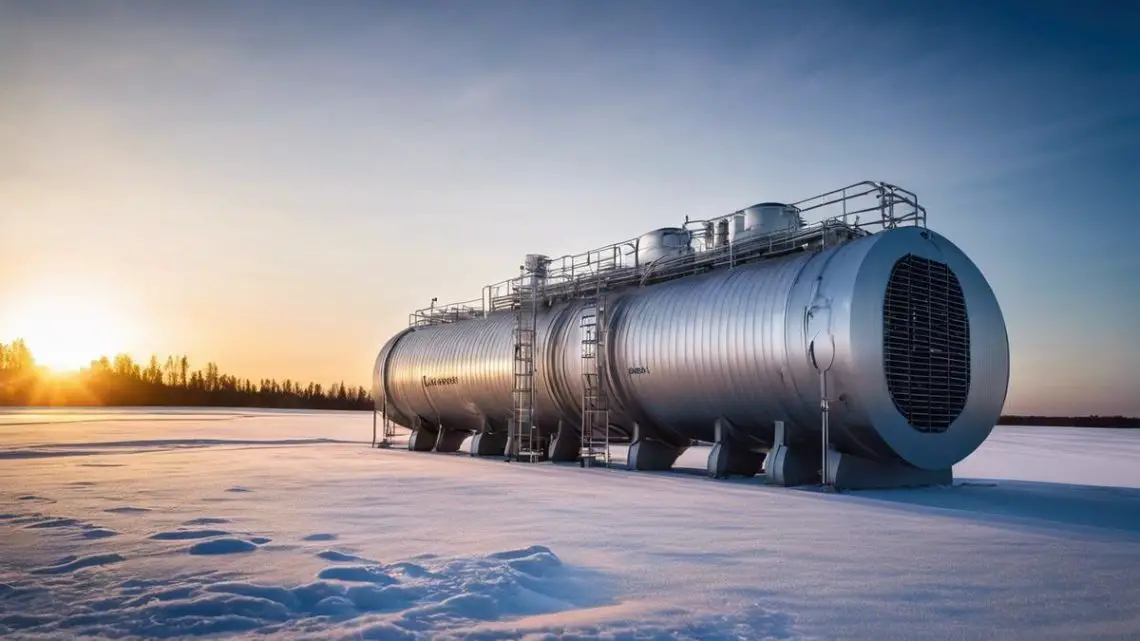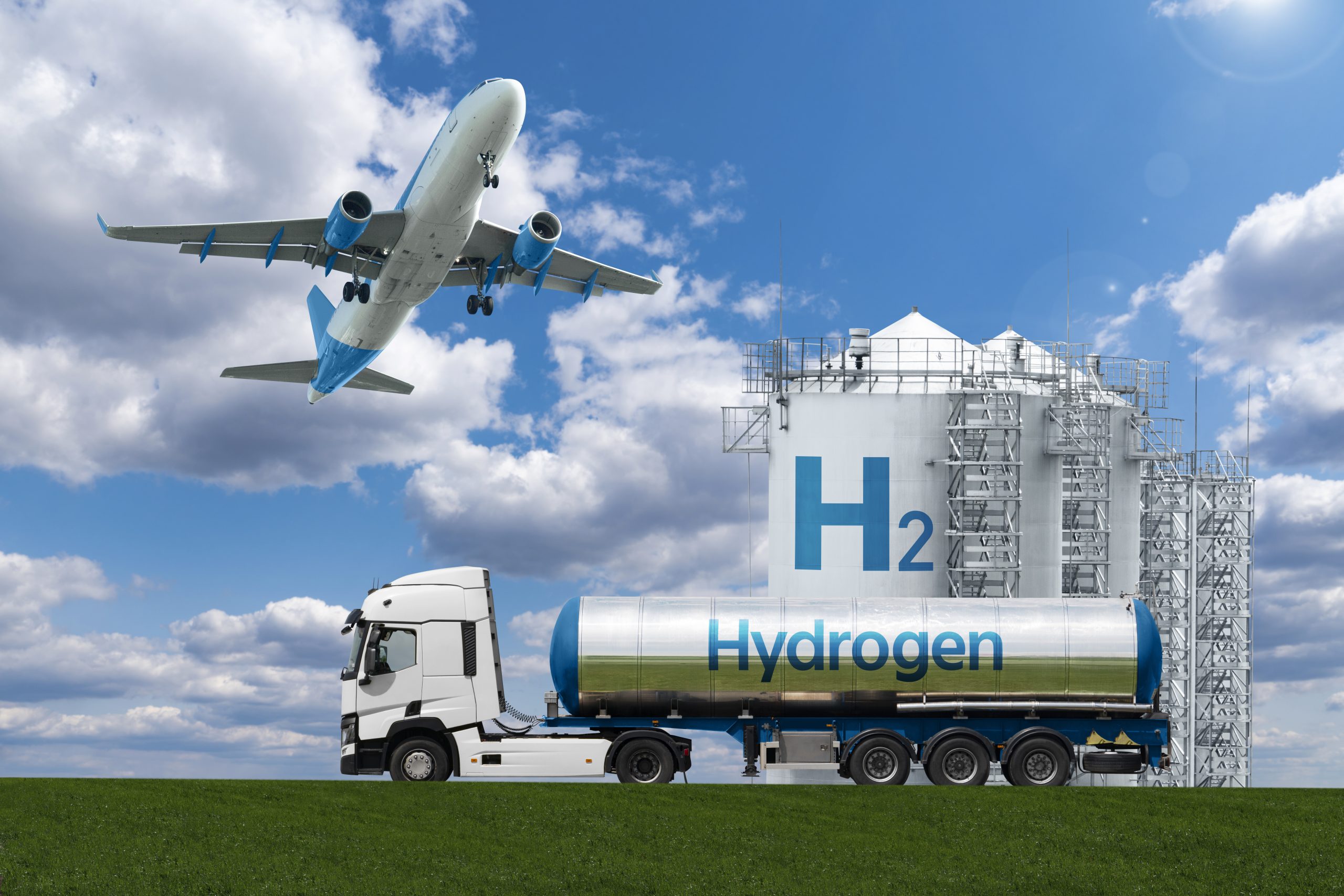
Cryo-Compressed Hydrogen in Aviation
January 17, 2024Cryo-compressed hydrogen, a potent energy source, is set to transform the aviation sector. This technology stores hydrogen at low temperatures and high pressures to increase energy density. Its use in aviation, led by ZeroAvia, brings the possibility of zero-emission air travel closer to fruition, marking a significant step towards sustainable global transportation.
Technological Fundamentals of Cryo-Compressed Hydrogen
Unlocking the Potential of Cryo-Compressed Hydrogen for Sustainable Energy
Cryo-compressed hydrogen is an advanced concept in the realm of energy storage and represents a significant milestone in the pursuit of sustainable and efficient fuel solutions. This approach ingeniously combines two hydrogen storage methods: cryogenic storage and high-pressure storage. By doing so, it capitalizes on the distinct advantages of each to optimize energy density and reduce the likeliness of hydrogen permeation and embrittlement of materials, which are prevalent challenges in the storage of hydrogen fuel.
Cryogenic storage entails cooling hydrogen gas to temperatures below -253 degrees Celsius to convert it into a liquid state. Liquid hydrogen boasts a higher energy density compared to its gaseous form, which means that more energy can be stored in a given volume, an attribute of immense value for applications where space and weight are at a premium, such as in aerospace.
Complementing cryogenic storage, high-pressure storage involves compressing hydrogen gas to pressures upwards of 350-700 bar. When hydrogen is compressed, the molecules are forced closer together, enabling the storage of a greater quantity of hydrogen in a given volume. This compression also contributes to an increase in the energy density of the stored hydrogen.
In cryo-compressed hydrogen storage, the hydrogen is first cooled to a cryogenic temperature and then compressed at high pressure within specially designed tanks. These tanks are built to sustain the extreme conditions without suffering degradation. The combination of both cryogenic and high-pressure techniques overcomes the limitations of each method when used in isolation. Storing hydrogen at low temperatures minimizes the need for compression, and vice versa, resulting in a more compact and efficient storage system.
The real ingenuity of cryo-compressed hydrogen, however, lies in its dynamic behavior during discharge and recharge cycles. As the hydrogen is depleted during energy release—whether used in a fuel cell to generate electricity or as a fuel source for combustion—its pressure naturally decreases. In response, the temperature within the storage tank rises, maintaining the pressure at a more constant level because of the intrinsic properties of hydrogen. This self-regulating system means that energy can be retrieved from the storage tank more consistently and reliably, a trait crucial for many energy applications.
As a cornerstone of the quest for renewable energy solutions, cryo-compressed hydrogen has the potential to make sustainable energy storage a reality, particularly in fields demanding high energy density and efficiency such as transportation sectors and beyond. Its sophisticated nature embodies a harmonious collaboration between science and technology, showcasing the feats achievable when dedication to research and development in sustainable energy is pursued with rigor and ambition.

Credit: Photo by depositphotos.com
Applications of Cryo-Compressed Hydrogen in Aviation
The Quest for Clean Skyward Travel: The Role of Cryo-Compressed Hydrogen in Future Aircraft Design
In the relentless pursuit of sustainable aerial mobility, cryo-compressed hydrogen emerges as a beacon of potential, promising a transformation of aviation industries and the broader transportation landscape. With the current paradigm shift towards eco-friendly energy sources, this innovative energy carrier stands out due to its exceptional gravimetric energy density—a measure of the amount of energy stored per unit weight—a pivotal attribute for anything that takes to the skies.
Understanding the Energy Paradigm in Aerial Vehicles
In the quest for cleaner skies, the weight of energy storage systems is a critical factor. Aircraft, intrinsically sensitive to weight, depend on the balance between energy density and mass to maintain performance while reducing environmental impact. Cryo-compressed hydrogen, with its superior energy-to-weight ratio, may hold the key to lighter, more energy-efficient designs, which can substantially extend the range and payload capabilities of conventional and emerging aircraft without emitting greenhouse gases.
The Synergy of High Density and Low Weight
Integrating cryo-compressed hydrogen into aerial vehicle design is no trivial task, but the advantages are substantial. This approach merges two primary benefits: the reduced volume per unit of energy offered by cryogenic storage and the high mass efficiency owing to compressed hydrogen’s lightweight characteristics. This dual advantage can lead to smaller, lighter fuel tanks conducive to streamlined aerodynamic profiles and less structural reinforcement—factors which could significantly enhance the operational efficiency and cost-effectiveness of flights.
Safety Measures and Regulatory Compliance
The implementation of cryo-compressed hydrogen in aerial mobility necessitates rigorous safety protocols and adherence to strict regulatory standards. Building upon advancements in material science, next-generation fuel tanks are engineered to withstand high pressures and low temperatures without compromising integrity. These safety measures, coupled with fail-safe engineering designs, are essential in ensuring that the transition to hydrogen-fueled aircraft satisfies all aviation safety requirements and instills confidence in passengers and stakeholders alike.
Strategic Integration into Aviation Infrastructure
Beyond aircraft design, the transition to hydrogen-fueled aviation involves a holistic modification of the existing infrastructure. From refueling stations to maintenance protocols, the entire support ecosystem must evolve. This challenge is met by interdisciplinary efforts to re-envision ground operations, with a focus on developing compatible interfaces for refueling and storage, that simultaneously ensure rapid turnaround times akin to conventional fueling procedures.
The Potential for Prolific Impact
As a consummate fulfillment of both cleaner energy practices and high efficiency, cryo-compressed hydrogen holds promise to redefine aerial mobility. The implications extend beyond commercial aviation into realms such as cargo transport, air ambulances, and eventually personal airborne vehicles. By embedding this technology into various facets of air transportation, the industry takes a significant leap towards carbon neutrality, aligning with global sustainability objectives.
Transitioning into a hydrogen-fueled future represents more than an incremental change; it denotes a pivotal reimagining of aerial travel—a synthesis of scientific pursuit and practical application that propels society toward an era of skyward sustainability without the tyranny of carbon emissions. Through collaborative efforts, ingenuity, and vision, cryo-compressed hydrogen stands on the precipice of catalyzing a revolutionary chapter in the annals of human mobility.
The journey towards clean aerial mobility is long and fraught with challenges, yet through the prism of cryo-compressed hydrogen, the destination appears not only attainable but resplendent with possibilities that could elevate the human experience to unprecedented heights.

ZeroAvia’s Role in Advancing Hydrogen-Fueled Aviation
As the landscape of aerial transportation undergoes a paradigm shift towards sustainable fuels, ZeroAvia stands as a pioneer in integrating hydrogen fuel technologies into aviation. The recent achievements of this innovative venture build upon the foundational understanding of cryo-compressed hydrogen storage and delve further into practical implementations that promise to revolutionize the aerospace industry.
ZeroAvia’s advancements have resulted in the conceptualization and prototyping of hydrogen-electric powertrains for aircraft. These powertrains are highly efficient systems that convert the chemical energy of hydrogen into electrical energy, which then powers the aircraft’s motors. The efficiency of such systems lies in their ability to circumvent the traditional internal combustion processes associated with aviation fuel, thus remarkably reducing carbon emissions. The powertrains play a crucial role in extending the range and payload capacities of aircraft while ensuring adherence to environmental standards.
To facilitate the use of hydrogen in aviation, ZeroAvia focuses on the safety and performance optimization of hydrogen-electric powertrains. Safety is of paramount importance, given the high energy content and specific properties of hydrogen as a fuel. The organization is developing rigorous testing protocols to ensure that these powertrains not only meet but exceed current safety regulations. These protocols aim to instill confidence in the aviation community and the traveling public alike, demonstrating that hydrogen can be as safe as conventional aviation fuels if not safer.
Moreover, ZeroAvia is resolving the complexities of integrating new hydrogen infrastructure within existing airport ecosystems. This involves the meticulous planning for refueling operations and maintenance practices that align with the schedules and flow of current air transport operations. By considering these aspects, ZeroAvia is addressing the logistical concerns that come with the adoption of a novel energy carrier such as hydrogen.
In the context of global air transportation sectors, ZeroAvia’s work is poised to have broad implications. The introduction of hydrogen-powered flight could vastly improve the carbon footprint of short-haul flights, a segment of aviation that, until now, has had limited alternatives to replace conventional jet fuel. By proving the feasibility of hydrogen in these aircraft, ZeroAvia lays the groundwork for larger-scale applications, potentially expanding to regional and ultimately long-haul flights.
The transition to hydrogen-fueled flight that ZeroAvia champions is transformative. It represents not a mere incremental change but a foundational leap toward sustainable, zero-emission air travel. As this initiative continues to gain momentum, the practical and environmental benefits of hydrogen powertrains could reinvent the aviation industry and contribute significantly to a cleaner, more sustainable future for global transportation.
Environmental and Economic Impact of Hydrogen in Aviation
The Role of Hydrogen-Powered Aviation in Sustainable Development: Exploring Ecosystem Impact and Economic Viability
As the aviation sector stands at the cusp of a sustainability revolution, hydrogen power has emerged as a cornerstone of this transformation. The environmental and economic implications of adopting hydrogen technology in aviation are multifaceted and warrant a detailed examination.
From an environmental perspective, hydrogen-powered flight promises significant reductions in atmospheric pollution. 
Unlike conventional hydrocarbon fuels which release carbon dioxide, an aviation sector powered predominantly by hydrogen would significantly lower its output of greenhouse gases. The combustion of hydrogen produces water vapor as its primary byproduct, a stark contrast to the suite of pollutants emitted from current jet fuels. Such a transition could play a crucial role in aiding international efforts to mitigate climate change by contributing towards the Paris Agreement goals.
Furthermore, the local environmental impact cannot be overstated. Airports situated in urban centers contribute a non-negligible amount of local air pollution. Switching to hydrogen fuel would lead to a cleaner immediate environment, potentially diminishing the health hazards associated with air quality around these urban infrastructures.
Economically, the integration of hydrogen into the aviation industry presents both opportunities and challenges. The development of hydrogen fuel cells and storage mechanisms has the potential to foster new industries and employment opportunities. Investment in research and development to further enhance the efficiency and safety of hydrogen-powered aviation could spur economic growth within the high-tech sector and catalyze innovation across ancillary markets.
However, it is critical to acknowledge the substantial costs associated with infrastructure overhaul. The shift to hydrogen aviation may necessitate significant alterations to airport fueling systems, maintenance facilities, and personnel training. This initial capital outlay will require strategic public and private sector investments and could entail an economic burden in the short term. The long-term economic viability of hydrogen aviation hinges upon the scalability of such technology and the eventual decline in production costs of green hydrogen.
Another economic dimension entails the potential impact on airline operating costs. While initial projections suggest higher fuel costs compared to traditional jet fuel, a market shift towards hydrogen could bring about economies of scale, reducing the disparity. Moreover, potential regulatory frameworks aimed at curbing emissions could make hydrogen more economically competitive through carbon taxes and emission trading systems.
The adoption of hydrogen as an aviation fuel represents not merely a technical shift but a fundamental re-imagining of the aerospace ecosystem. Its success is predicated on the synchronized alignment of policy-makers, industry stakeholders, and consumers. The evolution towards hydrogen in aviation is a composite process that requires the consideration of numerous variables and extensive planning to ensure a viable and sustainable integration into the global fabric of air travel without compromising safety, efficiency, or the economic structure of the industry.
The legacy of aviation could well be on the precipice of a new era, marked by clean skies above and greener landscapes below, as researchers and industry pioneers work diligently to align the art of flight with the tenets of environmental stewardship and sustainability.

Challenges and Future Prospects in Hydrogen Aviation
Fueling the Skies of Tomorrow: The Hydrogen Propulsion Paradox
In the contemplation of transitioning aviation from its dependency on conventional hydrocarbon fuels to a more sustainable hydrogen economy, several formidable challenges loom over the industry. One such challenge is the establishment of a global hydrogen fuel supply chain that is both reliable and extensive enough to meet the demands of a rapidly evolving aviation sector.
A critical encounter is pinpointing an economically viable method for the mass production of green hydrogen. Presently, the majority of hydrogen production is sourced from natural gas through a process called steam methane reforming, which paradoxically releases significant amounts of CO2. The adoption of renewable energy-powered electrolysis, albeit a cleaner alternative, remains financially exorbitant and thus hinders large-scale feasibility.
Furthermore, the aircraft design itself engenders specific complications. Hydrogen’s low volumetric energy density necessitates larger or more numerous fuel tanks, a design constraint that conflicts with aerodynamics and space optimization inside aircraft. Modifications in airframe design to accommodate these tanks could introduce additional weight, negating some of the benefits realized by hydrogen’s high gravimetric energy density.
Safety is another paramount concern, with hydrogen presenting unique risks due to its high flammability and low ignition energy. Entirely new systems for fuel containment, delivery, and management must be developed, tested, and certified to ensure the same level of safety passengers expect from current jet fuel-powered flights. These developments should be accompanied by substantial training programs for maintenance personnel and first responders.
An alignment of the currently disparate interests of airport operators, energy suppliers, aircraft manufacturers, and regulatory bodies is essential to surmount the challenges associated with hydrogen propulsion. This means not only co-developing aircraft and ground infrastructure in tandem but also formulating global standards for hydrogen production, storage, and refueling procedures in aviation contexts.
Moreover, the economic implications of converting to hydrogen foster a chicken-and-egg dilemma. The slow rollout of hydrogen-powered flight routes may deter investment in necessary infrastructure due to uncertain returns, while the lack of infrastructure, in turn, impedes the expansion of hydrogen-powered aviation.
Lastly, public perception and acceptance of hydrogen-fueled aircraft will decide the rate of adoption. It is incumbent upon those at the forefront of this technological pivot to effectively communicate the long-term environmental benefits and safety of hydrogen propulsion to engender confidence and demand from the traveling public.
In conclusion, while the zeal for a cleaner aviation industry is palpable, the road to hydrogen-fueled aircraft requires a synergy of science, economics, and public policy that is unprecedented in modern aviation history. The successful realization of this future hinges on the collaboration of various stakeholders, significant investment in research and development, and the fostering of an environment where innovation is both supported and incentivized.

As we navigate through the complexities and potential of hydrogen in aviation, the insights gained underscore the magnitude of transformation that this energy vector can usher in for our skies. ZeroAvia’s trailblazing efforts highlight not only the technical feasibility but also underscore the broader environmental and economic ripple effects such innovations can create. Despite the towering challenges that lay ahead, from infrastructure to public perception, the horizon is not just hopeful; it’s charged with the potential for a complete overhaul of aviation as we know it. The journey towards a more sustainable future is both exciting and daunting, but as the cogs of progress turn, they promise a cleaner, more efficient era of air travel for generations to come.



 HFN News is your leading source for fresh hydrogen and renewable energy updates. Amid the fast-paced growth of hydrogen companies, we provide top-notch news and insights about this exciting sector. Our coverage spans from hydrogen cars to global sustainable initiatives, and we highlight the latest in green jobs and developing hydrogen hubs. We invite you to share your local hydrogen news and explore today’s renewable energy job listings on our site. Thanks for choosing HFN News as your trusted guide to the hydrogen and renewable energy world!
HFN News is your leading source for fresh hydrogen and renewable energy updates. Amid the fast-paced growth of hydrogen companies, we provide top-notch news and insights about this exciting sector. Our coverage spans from hydrogen cars to global sustainable initiatives, and we highlight the latest in green jobs and developing hydrogen hubs. We invite you to share your local hydrogen news and explore today’s renewable energy job listings on our site. Thanks for choosing HFN News as your trusted guide to the hydrogen and renewable energy world!